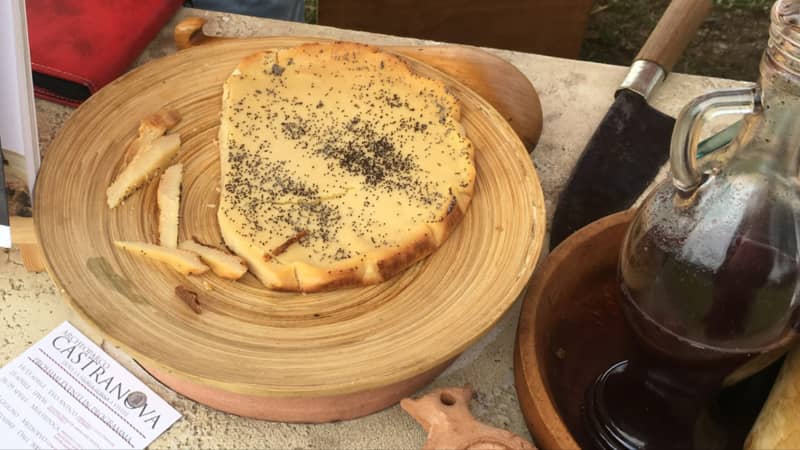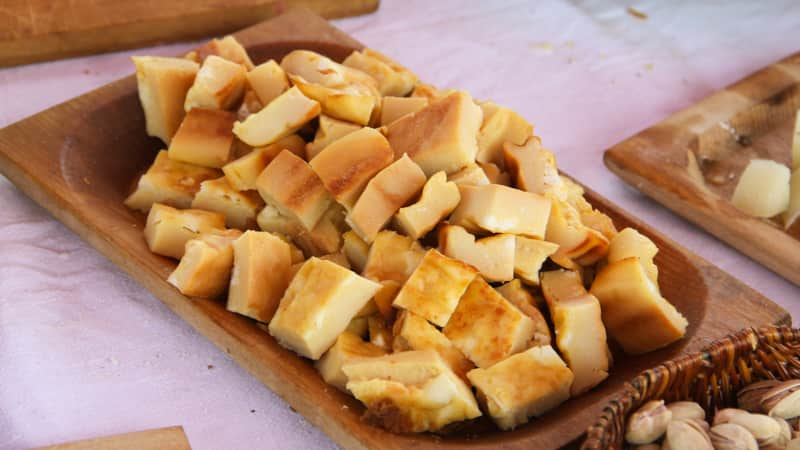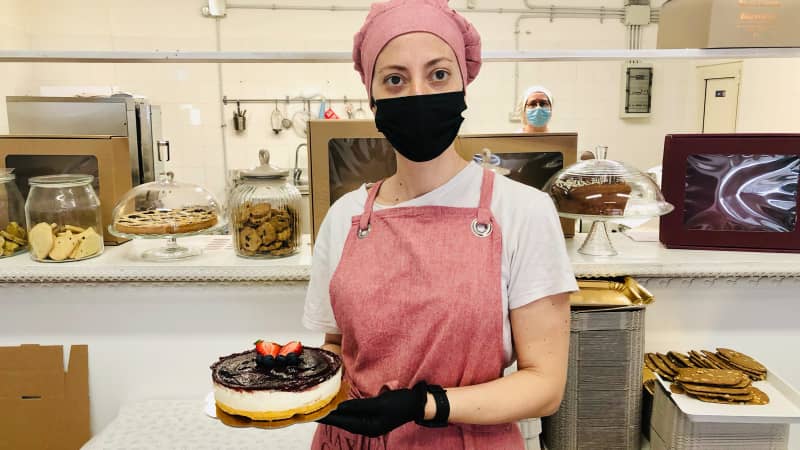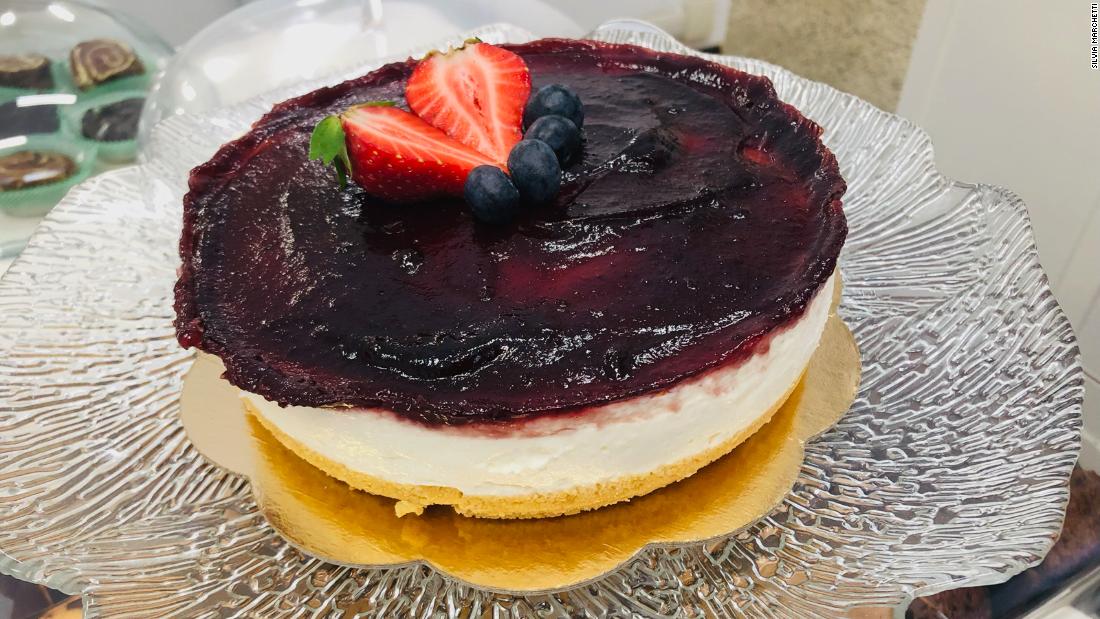Rome (CNN) — It was nutritious, easy to prepare and great as a snack, especially when sprinkled with poppy flower seeds and served in cubes.
The ancient Romans feasted on a delicious honey-crusted cheesecake called Savillum, which is believed to be the real ancestor of modern US-style cheesecake.
Instead of Philadelphia soft cheese, there was fresh goat milk ricotta straight from the shepherds. It was adored by slaves, aristocrats and soldiers.
History’s first fully documented recipe detailing the preparation of a delicacy that comes close to modern cheesecake dates back to the third century BCE, and it was written by a prominent ancient Roman senator, army general and historian.
“Cato the Elder was not just a great writer and philosopher, he was a gourmet and supporter of rural traditions and foods,” says Giorgio Franchetti, a food scholar of ancient Rome and author of the book “Dining With The Ancient Romans.”
Franchetti says Cato recorded the recipe for his favorite cake, Savilium, in one of his key works, “De Agri Cultura.” It was, he tells CNN, “very popular in Roman households.”
A cake with legs

US-style cheesecake is now gaining popularity in Italy.
Silvia Marchetti
Many myths and stories have been spun around the creation of this popular dessert, says Franchetti, but he insists only the one of its Roman origin has legitimacy.
Thanks to the expansion of the Roman Empire, Savillum spread everywhere, eventually landing in England and then, centuries later, in the New World, evolving over time and taking on local twists.
“Savillum had very long legs, it traveled the globe,” says Franchetti, who has unearthed many ancient Roman recipes. “In time the Romans perfected the cooking and preparation technique, bringing it to their colonies, which spread from the Middle East to Britannia.
“It was a very basic cake made with simple everyday ingredients: goat milk, honey and eggs. And thanks to Cato we even know the precise quantities of each.”
According to another origin tale, a “rudimentary” generic dessert of cheese and honey was first made by the ancient Greeks before the Romans, in the 8th century BCE, and used to give an energy boost to Olympic athletes.
However, the few secondary Greek sources that mention the dish, says Franchetti, do not give specific details about how it was made or what it looked like, let alone offer a precise recipe.
Even if it was adopted and refined by Greece’s Roman conquerors, he adds, it was the Romans who globalized Savillum, not the Greeks.
‘Bake well the deep center’

A well-cooked Savillium resembles and omlet.
Giorgio Franchetti
In his recipe, Cato offers exact instructions and tips on making the cheesecake.
He says to mix half a libra of flour (1 Roman libra was roughly 11.5 ounces or 327 grams), 2.5 libra of goat cheese (aka ricotta), one egg and a quarter libra of honey inside a terracotta pot previously greased with olive oil, cover it with a lid and then place it on the fire.
Cato explicitly advises to make sure to thoroughly bake the deep, thicker center. “Once baked, pour over it honey and sprinkle poppy flower seeds on top, then place back on the fire to finalize the baking before serving it,” says the recipe
Savillum was likely served spoonless, as the Romans liked to eat with their fingers, but was cubed to make it easier. It was typically eaten throughout the meal rather than at the end as a dessert.
Cato’s Savillum can still be tasted today, alongside other ancient Roman dishes recreated at elite “Roman dinners” organized at archaeological sites in Italy by Franchetti and “archeo-cook” Cristina Conte, who recreates recipes from the Eternal City.
The private events usually see diners dressed in typical Roman robes for the imperial vibe.
“Savillum is extremely easy and quick to make, just two hours, way less than cheesecake,” says Conte, who also cooks ancient Roman dishes at home with her family. “It has an exquisite sweet-sour taste due to the honey and cheese.”
“It was a very humble treat regularly savored both by low and aristocratic families. I bake it in an oven or wood oven when possible, and I adore it served still warm, when it’s puffy and creamy.”
When baked to perfection, Savillum resembles a roundish pancake or omelet, slightly yellowish and with an overcooked surface. The Romans also made a variant of it with apples and pears, according to Conte.
Italian heirs

Romans loved to eat cubed cheesecake as a snack between meals.
Giorgio Franchetti
Today, Savillum’s legacy can be found in numerous classic Italian desserts.
Most pastries and cakes made with cheese products such as ricotta, mascarpone and burrata can trace their lineage to it.
Naples’ pastiera, Sicilian cassata and “granny cake,” a classic tart with ricotta, lemon and pine nuts are relatives. As are Sardinia’s seadas made with pecorino sheep cheese and honey, Latium’s Laurina tart with ricotta and chocolate, and sfuagghiu from the Sicilian village of Polizzi Generosa, made with Tuma sweet sheep cheese, candied pumpkin, cinnamon and cocoa.
Then there’s Italian-style cheesecake. Thanks to globalization, Savillum has come back to its origins via American cheesecake, and has been transformed into a sweet trend in Italy..
The torta alla robiola, a cake made with a special kind of soft cheese popular in north Italy, is identical to the classic New York cheesecake — bar the Philadelphia cream cheese — and has a base made of crushed artisan cookies.
Despite being weaned on delicious indigenous pastries — from cannolo to Tiramisu, which also feature some kind of cheese — Italians have come to adore American cheesecake, oblivious to its Roman origins.
Many resorts, pastry shops and restaurants now have it on their menu, and not just in big touristy cities that cater to foreign tastes. Today you can find eateries with cheesecake even in deepest Sicily, considered the “kingdom” of Italian desserts.
‘Reincarnated’ homecoming

Simona Orlandi: US cheesecake is “refreshing and pleasant” in the Italian summer.
Silvia Marchetti
Biscomania is a niche artisan cake and cookie boutique in the tiny rural town of Capena, near Rome. It prepares traditional US cheesecakes and Italianized twists with pistachio, nutella and red fruit jam topping. Philadelphia cheese, mascarpone, ricotta or yoghurt is used, depending on the tastes of clients, who tend to buy it for special occasions.
And while many cheesecakes require baking, others set through refrigeration, with no baking required.
“It’s not just part of a growing American fad,” says Biscomania owner Simona Orlandi. “Refrigerated cheesecake is like a sort of semifreddo, very refreshing and pleasant in summer. Young people usually order it, they’re the most Americanized around here.
“Apart from the US, unbaked cheesecake is perhaps the most popular among Italians. Given it requires no preparation, baking and leavening, families have started making it at home too. It’s a great do-it-yourself cake.”
Because Italian meals are typically quite filling, Orlandi advises to avoid eating cheesecake as a meal-end dessert as it requires, in her view, a lot of extra digestive power.
Franchetti himself is a fan of cheesecake and says its story shows that even food can be an archaeological treasure.
“Even though we may have lost traces of what happened to Savillum across time, we know with certainty that it fully reincarnated in cheesecake, which the anglophone culture re-distributed worldwide.
“The ancient Romans invented and spread it millennia ago, and today Romans have received it back from places once under the rule of Rome. In a way, cheesecake has returned home.”
